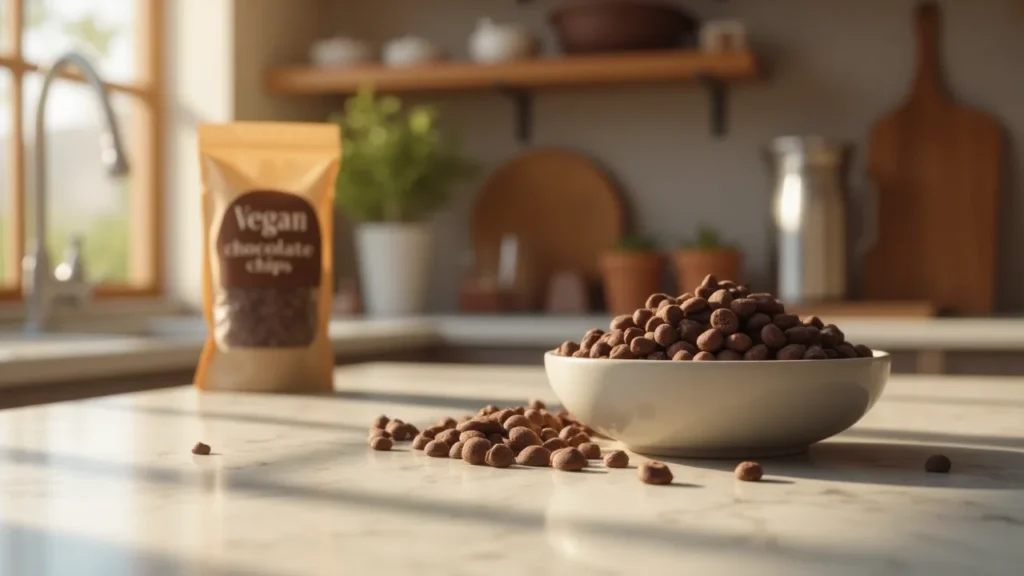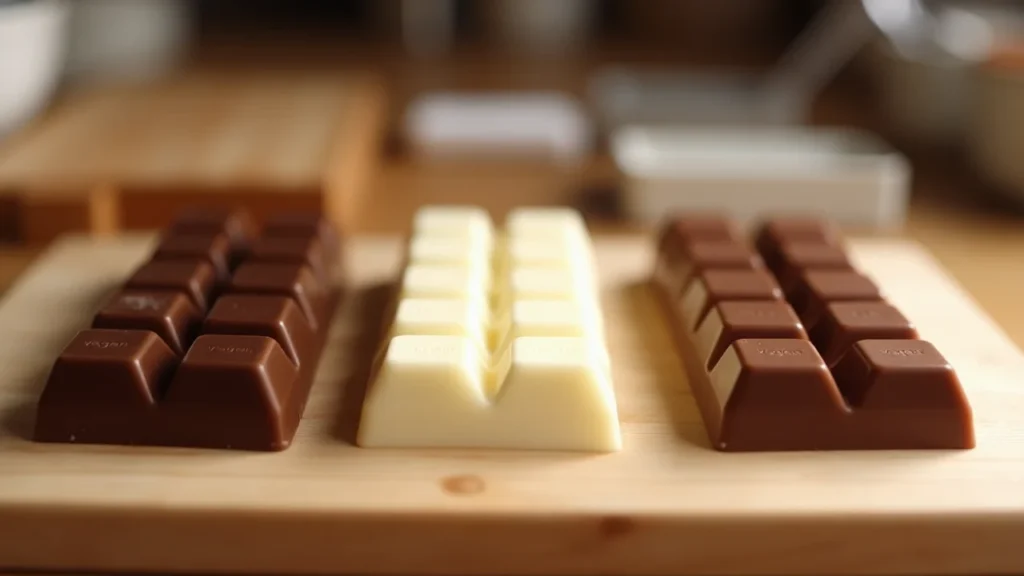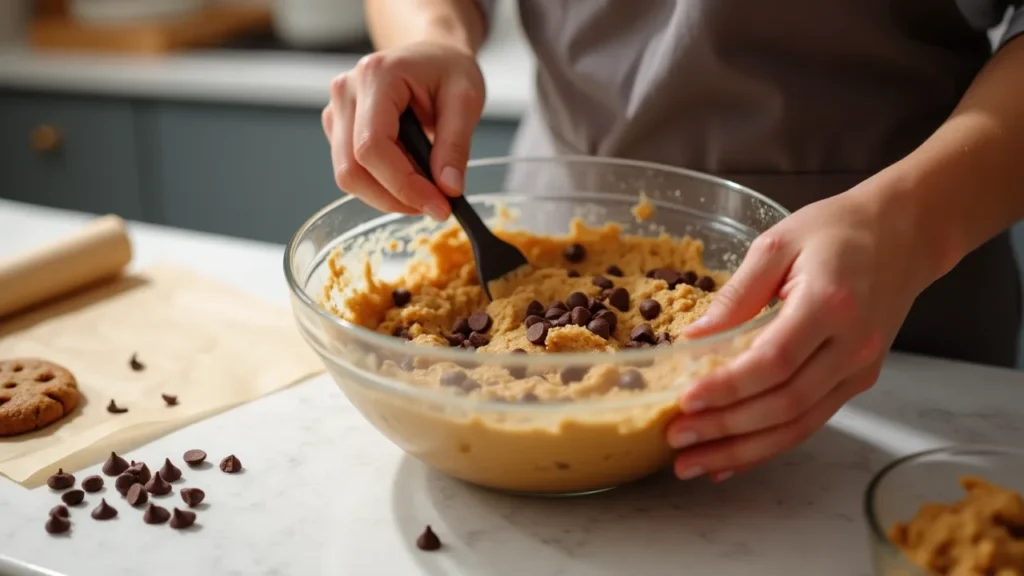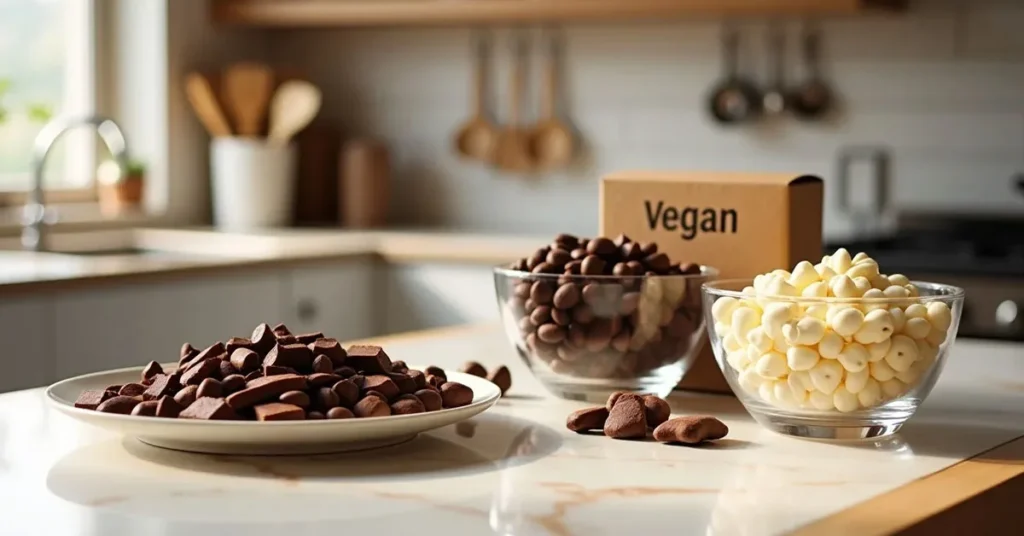Vegan Chocolate
Table of Contents
Introduction
There was a time when indulging in chocolate while following a plant-based lifestyle felt like wishful thinking. But not anymore. Vegan chocolate has surged in popularity, not just among vegans, but also health-conscious foodies, lactose-intolerant dessert lovers, and ethically-minded bakers.
Behind this movement is more than just a craving for sweetness — it’s a commitment to ingredients that respect animals, health, and sustainability. From smooth vegan chocolate chips to rich, melt-in-your-mouth dark chocolate bars, plant-based options today are as decadent as their traditional counterparts — often even better.
In this complete guide, we’ll unwrap the secrets of vegan chocolate — what it really is, how it differs from conventional varieties, how to choose the best brands, and how to use it successfully in baking. Whether you’re asking “Is chocolate vegan?”, exploring dairy-free alternatives, or seeking baking tips for your next indulgent creation, you’re in the right place.
Let’s dive into the delicious world of vegan and chocolate, with expert insights and practical advice from your digital pâtissier, ChocoChefAI.
What Is Vegan Chocolate?
At its core, vegan chocolate is simply chocolate made without any animal-derived ingredients — no milk, no butterfat, no whey, no sneaky additives like casein or lactose. It’s crafted to satisfy your sweet tooth without compromising a plant-based lifestyle.
Traditional chocolate, even in its simplest form, comes from cocoa beans. When these beans are fermented, dried, roasted, and ground, they form a rich paste called cocoa mass (or liquor), which is the base of most chocolate. Add cocoa butter (naturally dairy-free) and a sweetener, and you get dark chocolate. But here’s the catch: many brands add milk solids or other dairy derivatives for texture and sweetness — making them unsuitable for vegans.
How Is Vegan Chocolate Different?
Vegan chocolate is made entirely without animal-derived ingredients, opting instead for plant-based components in every step. This means:
- No cow’s milk — often swapped with oat milk, coconut milk, or almond milk
- No milk fats or butter — replaced with cocoa butter or plant oils
- No refined sugar processed with bone char (in some ethical brands)
Despite the lack of dairy, high-quality vegan chocolate can still be:
- Smooth and creamy
- Deeply flavorful
- Perfect for baking and snacking
In fact, many dark chocolates with high cocoa percentages (70% and above) are naturally vegan — but always check the label!
Common Non-Vegan Ingredients to Watch Out For
| Ingredient | Why It’s Not Vegan |
| Milk powder | Derived from dairy |
| Whey | A byproduct of cheese-making |
| Casein | Milk protein |
| Butterfat | Dairy-based fat |
| Lecithin (from eggs) | Sometimes used as emulsifier |
When reading a chocolate label, look out for clear vegan certifications or phrases like “dairy-free,” “100% plant-based,” or “suitable for vegans.”
Plant-Based Additions That Make the Difference
Vegan chocolatiers have become increasingly creative. You’ll now find options that include:
- Coconut cream for richness
- Cashew or oat milk for a creamy texture
- Naturally derived sweeteners such as agave nectar, coconut sugar, or pure maple syrup offer wholesome alternatives to refined sugars
- Ethically sourced cocoa with fair-trade or organic certifications
This blend of culinary innovation and ethical sourcing makes vegan chocolate a true star in modern desserts.
Are Chocolate Chips Vegan?

If you’ve ever reached for a bag of chocolate chips and paused mid-recipe wondering “Are chocolate chips vegan?”, you’re not alone. The answer? Some are, many aren’t — and the difference comes down to a few critical ingredients.
While chocolate chips may seem simple — cocoa, sugar, fat — many commercial varieties include milk solids, milkfat, or emulsifiers derived from animals. That means your favorite chocolate chip cookie might be sneaking in dairy, even if the rest of the recipe is plant-based.
What Makes a Chocolate Chip Vegan?
To be considered truly vegan, chocolate chips must exclude all animal-derived ingredients, including:
- Milk powder
- Whey or casein
- Butterfat
- Artificial flavorings derived from animal products
- Sugar processed with bone char (in some non-organic versions)
Instead, vegan chocolate chips typically use:
- Cocoa mass or cocoa liquor
- Cocoa butter (plant-based)
- Organic cane sugar or unrefined sweeteners
- Sunflower or soy lecithin (plant-based emulsifier)
Best Vegan Chocolate Chip Brands
Not all brands label their chocolate chips clearly. To help, here’s a quick table featuring popular options and their vegan status:
| Brand | Certified Vegan | Cocoa % | Notable Info |
| Enjoy Life | ✅ Yes | ~40% | Free from 14 allergens, no dairy |
| Hu Kitchen | ✅ Yes | ~70% | Paleo, organic coconut sugar |
| Trader Joe’s | ⚠️ Check label | Varies | Some are vegan, some contain milk |
| Lily’s Sweets | ✅ Stevia-based | ~55% | Sugar-free, keto-friendly, some are vegan |
| Ghirardelli | ❌ Not always | ~60%+ | Most varieties contain milk derivatives |
ChocoChefAI Tip: Look for brands that specifically mention “vegan,” “dairy-free,” or “plant-based” on the package.
Uses for Vegan Chocolate Chips
These chips aren’t just for cookies! Their versatility makes them a plant-based baker’s best friend:
- Muffins and banana bread
- Vegan brownies
- Chocolate chip pancakes
- Melted into ganache or sauces
- Blended into smoothies or energy bites
Thanks to improved formulations, vegan chocolate chips melt beautifully, retain shape in baked goods, and offer rich chocolate flavor with none of the dairy.
Is Dark Chocolate Vegan? What About White or Milk?

Chocolate varies greatly in composition—and when it comes to vegan-friendly options, not every bar makes the cut. Some chocolate lovers assume dark chocolate is always vegan and milk or white chocolate is always off-limits. But the reality is a bit more nuanced.
Is Dark Chocolate Vegan?
Often, yes — but not always.
Dark chocolate generally contains:
- Cocoa mass or cocoa solids
- Cocoa butter (which is vegan, despite the name)
- Sugar
Higher cocoa percentages (typically 70% and above) often mean fewer ingredients — and less likelihood of dairy being included. That said, certain brands quietly incorporate milk-based additives to improve texture or enhance flavor.
To be safe:
Always check the label for:
- Milk powder
- Whey
- Butterfat
- Casein
- Emulsifiers not specified as plant-based
💡 Look for brands that state “vegan” or “dairy-free” — or opt for certified vegan dark chocolate to be sure.
Is White Chocolate Vegan?
Traditionally, no.
White chocolate is usually made with:
- Cocoa butter
- Milk powder or milk solids
- Sugar
- Vanilla or flavorings
That said, a new wave of vegan white chocolate is emerging, replacing dairy with:
- Coconut milk powder
- Cashew or oat milk bases
- Plant-based emulsifiers
ChocoChefAI Tip: Vegan white chocolate has a subtly different flavor — slightly nuttier or coconutty depending on the milk base — but can still be silky-smooth and perfect for melting, coating, or baking.
Is Milk Chocolate Vegan?
Traditionally, no — but vegan versions exist.
Milk chocolate gets its creamy texture from dairy milk solids — but modern vegan chocolatiers are crafting milk-style chocolate using:
- Almond milk
- Coconut milk
- Rice or oat milk
- Cashew milk
These vegan substitutes replicate the smooth, creamy texture of milk chocolate while entirely avoiding any animal-derived ingredients.
Vegan milk chocolate is perfect for:
- Candy bars
- Ganache fillings
- Hot chocolate mixes
- Vegan truffles
Summary: Vegan Status by Chocolate Type
| Chocolate Type | Usually Vegan? | Notes |
| Dark Chocolate | ✅ Sometimes | Look for 70%+ cocoa, check for hidden milk |
| Milk Chocolate | ❌ Rarely | Choose vegan alternatives with plant milks |
| White Chocolate | ❌ Rarely | Look for dairy-free brands using nut/coconut milk |
How to Melt Vegan Chocolate Like a Pro
Whether you’re preparing a silky ganache, a glossy drizzle, or dipping fresh strawberries, melting vegan chocolate correctly is essential to preserve its smooth texture and deep flavor. Done wrong, and you risk burning it or causing it to seize. But don’t worry — here’s how to do it right.
The Golden Rule: Low and Slow
Vegan chocolate, just like all types of chocolate, is delicate and reacts easily to heat and humidity. High heat will scorch it. Water will cause it to clump. Stick to these proven techniques:
1. Double Boiler Method (Best for control)
This gentle, steam-based method is ideal for melting chocolate evenly.
Steps:
- Chop the vegan chocolate into small, uniform pieces.
- Bring a small pot of water to a simmer (not boiling).
- Place a heat-safe bowl over the pot — ensure it doesn’t touch the water.
- Place the chocolate into the bowl and mix slowly until it has fully melted.
Why it’s great: Reduces the risk of scorching, maintains smooth texture.
2. Microwave Method (Fast but needs caution)
Perfect if you’re short on time, but requires attention to avoid overheating.
Steps:
- Place chopped vegan chocolate in a microwave-safe bowl.
- Heat in 15–20 second bursts, stirring after each round.
- Stop when most of the chocolate is melted — then stir to melt the rest.
ChocoChefAI tip: Use 50% power for gentler heating if your microwave allows.
What to Avoid
- Water contact: Even a drop can cause the chocolate to seize (turn grainy and stiff).
- High heat: It can burn the sugars and fats, making it bitter and unusable.
- Overstirring: Stir gently — overmixing can add air bubbles and affect texture.
Perfect Uses for Melted Vegan Chocolate
- Drizzling over vegan cakes, muffins, or ice cream
- Making truffles or fudge
- Dipping fruit, nuts, or cookies
- Swirling into oatmeal or chia pudding
- Glazing vegan donuts or cupcakes
Bonus Tip from ChocoChefAI
Looking for a super shiny finish? Stir in a teaspoon of coconut oil or vegan butter while melting your chocolate. This not only boosts the gloss but also helps with smooth drizzling.
Baking Tips with Vegan Chocolate

Baking with vegan chocolate is both a joy and a delicate craft. Whether you’re making cookies, brownies, or cakes, these tips will help you get perfect results every time — rich, smooth, and irresistibly chocolatey.
Choose the Right Chocolate
- Use high-quality vegan chocolate or chips: The flavor and texture depend heavily on the base chocolate, so don’t skimp.
- Opt for couverture or baking bars when melting — they have higher cocoa butter content, which melts smoothly.
- Adjust sugar content if your vegan chocolate is very dark or bitter.
Proper Melting and Tempering
- Melt chocolate slowly (see previous section) to avoid burning or seizing.
- If your recipe requires tempered chocolate (for coating or decorations), use a thermometer and follow tempering steps carefully to get that perfect glossy finish and crisp snap.
Substitutions for Dairy Ingredients
If your recipe requires milk or butter, consider replacing them with these alternatives:
- Plant-based milks: Almond, oat, coconut, or soy milk work well.
- Vegan butter or coconut oil: Great for moisture and richness.
Enhance Texture and Flavor
- Add espresso powder or coffee: Just a teaspoon enhances chocolate’s richness without tasting like coffee.
- Add a small pinch of salt to your mixture—it helps to balance out the sweetness while enhancing the overall flavor.
- Incorporate vanilla extract: A classic companion to chocolate that deepens aroma.
Avoid Common Pitfalls
- Don’t overmix batter: Overworking gluten in flour leads to dense baked goods.
- Use room temperature ingredients: Helps achieve even mixing and smooth texture.
- Don’t overbake: Vegan chocolate baked goods can dry out quickly — start checking a few minutes before the recommended time.
Baking Ideas Using Chocolate Vegan
| Recipe Idea | Chocolate Form | Notes |
| Vegan chocolate chip cookies | Vegan chocolate chips | Keep chips whole for texture |
| Vegan brownies | Melted vegan chocolate | Use couverture bars for fudginess |
| Chocolate vegan cake | Vegan dark or milk-style | Add vegan butter for moist crumb |
| Vegan chocolate mousse | Melted vegan chocolate | Use coconut cream for richness |
How to Choose the Right Vegan Chocolate
With countless choices on the market, selecting the ideal vegan chocolate can quickly become a daunting task. Here’s how to read ingredient labels and understand what to look for — so you pick the best chocolate for your recipe or snack.
Reading Ingredient Labels
- Look for clear “vegan” or “dairy-free” labels: This is the easiest way to confirm the chocolate is vegan-friendly.
- Avoid ingredients like:
- Milk powder, milk fat, whey, casein (all dairy derivatives)
- Butterfat or cream
- Certain emulsifiers like lecithin that may not be plant-based unless specified
- Watch for hidden animal ingredients: Some chocolates use refined sugar processed with bone char — some vegans avoid this, so check brand policies if this matters to you.
Cocoa Percentage, Sugar, and Added Oils
- Cocoa Percentage:
Generally, chocolates with a cocoa content of 70% or higher contain less sugar and fewer added ingredients. Darker vegan chocolates tend to be purer and richer. - Sugar Content:
Vegan chocolates can use organic cane sugar or coconut sugar. Be mindful of sugar quantity, especially for baking sweeter treats. - Added Oils:
Certain vegan chocolates incorporate cocoa butter or plant-derived oils such as sunflower or palm oil to enhance their texture and melting qualities. Avoid chocolates with hydrogenated or palm oils if you prefer cleaner ingredients.
Vegan and Chocolate: What About Chocolate Chips Vegan?
- Vegan chocolate chips are specially formulated without dairy — ideal for cookies and baking.
- Always check the packaging to confirm if they are labeled vegan and free from cross-contamination.
- Vegan chocolate chips may have slightly different melting properties; use baking tips accordingly.
Recipes That Use Vegan Chocolate

Vegan chocolate is incredibly versatile! Here are some delicious recipe ideas featuring different forms of vegan chocolate to inspire your next baking adventure.
| Recipe Type | Chocolate Format Used | Description |
| Vegan Brownies | Melted vegan dark chocolate | Fudgy, rich, and perfect for sharing |
| Vegan Chocolate Chip Cookies | Vegan chocolate chips | Classic, chewy cookies with melty chips |
| Vegan Chocolate Mousse | Melted vegan chocolate | Silky, creamy dessert made with coconut cream |
| Vegan Chocolate Cake | Vegan dark or milk-style bars | Moist and tender cake for celebrations |
| Vegan Chocolate Ganache | Melted vegan chocolate | Perfect glaze or filling for desserts |
Each recipe highlights the unique qualities of vegan chocolate in different forms — from chips for texture to melted chocolate for smoothness and shine.
Final Thoughts from ChocoChefAI
Exploring the world of vegan chocolate opens up delicious possibilities for everyone, whether you’re baking, snacking, or creating gourmet treats. Remember these key takeaways:
- Always read ingredient labels carefully to ensure your chocolate is truly vegan.
- Choose the right type of chocolate for your recipe — from vegan chocolate chips to high-quality dark bars.
- Master gentle melting techniques to keep your chocolate smooth and glossy.
- Use baking tips to enhance flavor and texture, ensuring your vegan creations shine every time.
Don’t hesitate to experiment with different chocolates and recipes — the beauty of vegan chocolate is in its versatility and rich flavor profiles.Ready to dive in? Try one of our delicious vegan chocolate recipes, share your results in the comments, and spread the love by sharing this post with fellow chocolate lovers!
— ChocoChefAI
FAQ About Vegan Chocolate
1. Is chocolate vegan by default?
Not always. While pure cocoa is plant-based, many commercial chocolates contain milk or other animal-derived ingredients. Always check labels to be sure.
2. Are chocolate chips vegan?
While certain chocolate chips qualify as vegan, this is not universal. Vegan chocolate chips are made without any dairy or animal-derived substances. To be certain, always seek out products marked “vegan” and carefully inspect their ingredient lists.
3. Is dark chocolate vegan?
Most dark chocolates are vegan because they contain a high percentage of cocoa solids and less or no milk. However, some brands add milk fats or butter, so it’s important to check.
4. Is white chocolate vegan?
Traditional white chocolate contains milk fat and is not vegan. Vegan versions use plant-based milk alternatives and cocoa butter without dairy.
5. Is black chocolate vegan?
“Black chocolate” typically refers to very dark chocolate. Like dark chocolate, it’s often vegan, but always verify the ingredients.
6. Can I bake with vegan chocolate chips the same way as regular chips?
Yes! Vegan chocolate chips behave similarly in baking but may melt slightly differently. Use room temperature ingredients and gentle mixing to preserve texture.

